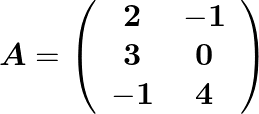Solution:
We have  and
and  .
.
Now if number of columns in left matrix is equals to the number of rows in right matrix, multiplication of two matrices is possible.
Now discuss the order of the matrices which are given. The order of matrix ![]() is
is ![]() and matrix
and matrix ![]() is
is ![]() .
.
Hence, the multiplications we can proceed as,
(i) The multiplication ![]() is possible.
is possible.
Hence 

(ii) The multiplication of ![]() is not possible as if number of columns in left matrix is 2 which is not equals to the number of rows in right matrix i.e, 3 .
is not possible as if number of columns in left matrix is 2 which is not equals to the number of rows in right matrix i.e, 3 .

![Rendered by QuickLaTeX.com A=\left[\begin{array}{cc} 2 & -1 \\ 3 & 0 \\ -1 & 4 \end{array}\right] \text { and } B=\left[\begin{array}{cc} -2 & 3 \\ 0 & 4 \end{array}\right]](https://www.learnatnoon.com/s/wp-content/ql-cache/quicklatex.com-21ad4759d8ac8e3299f333785850143c_l3.png)